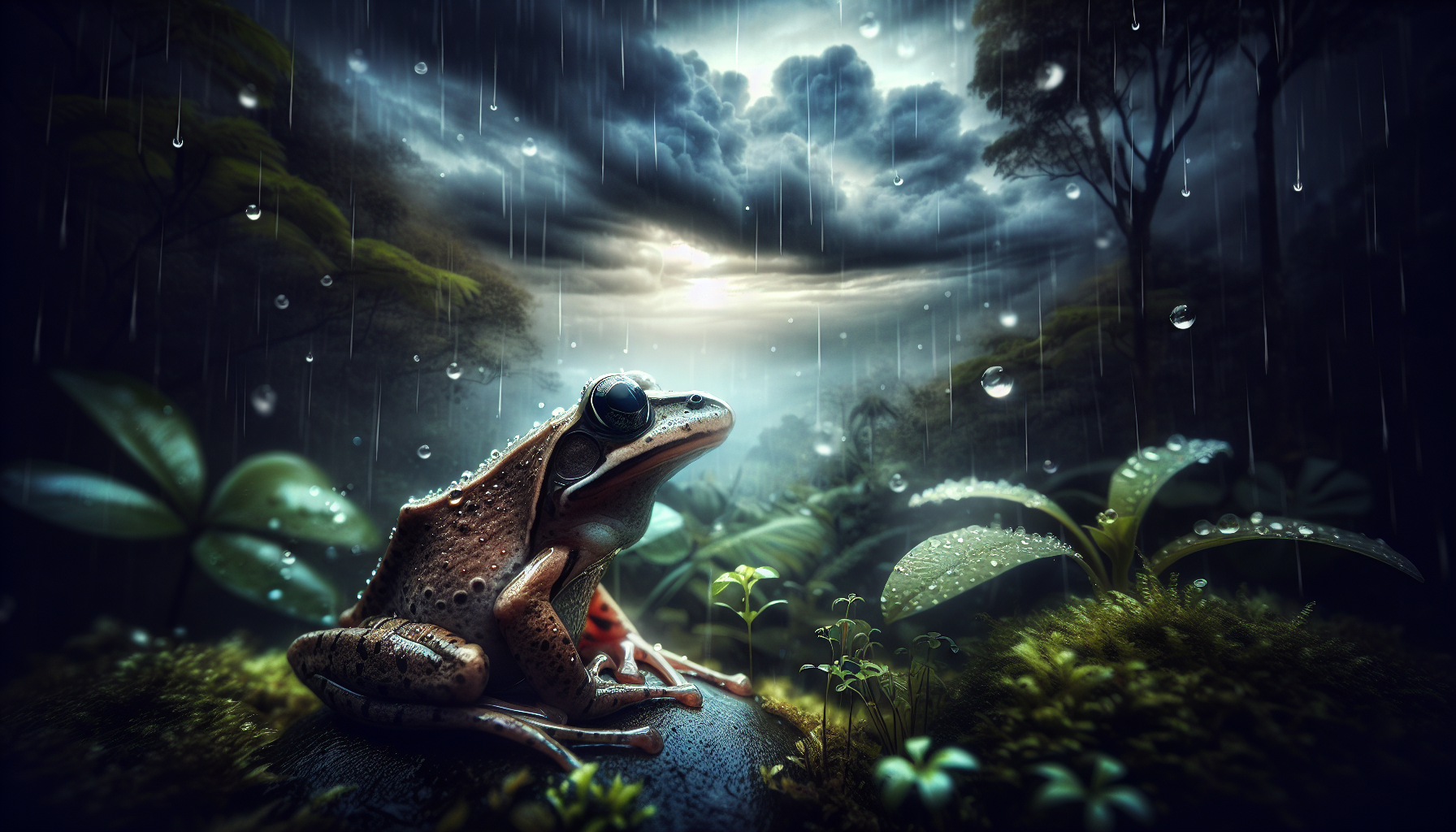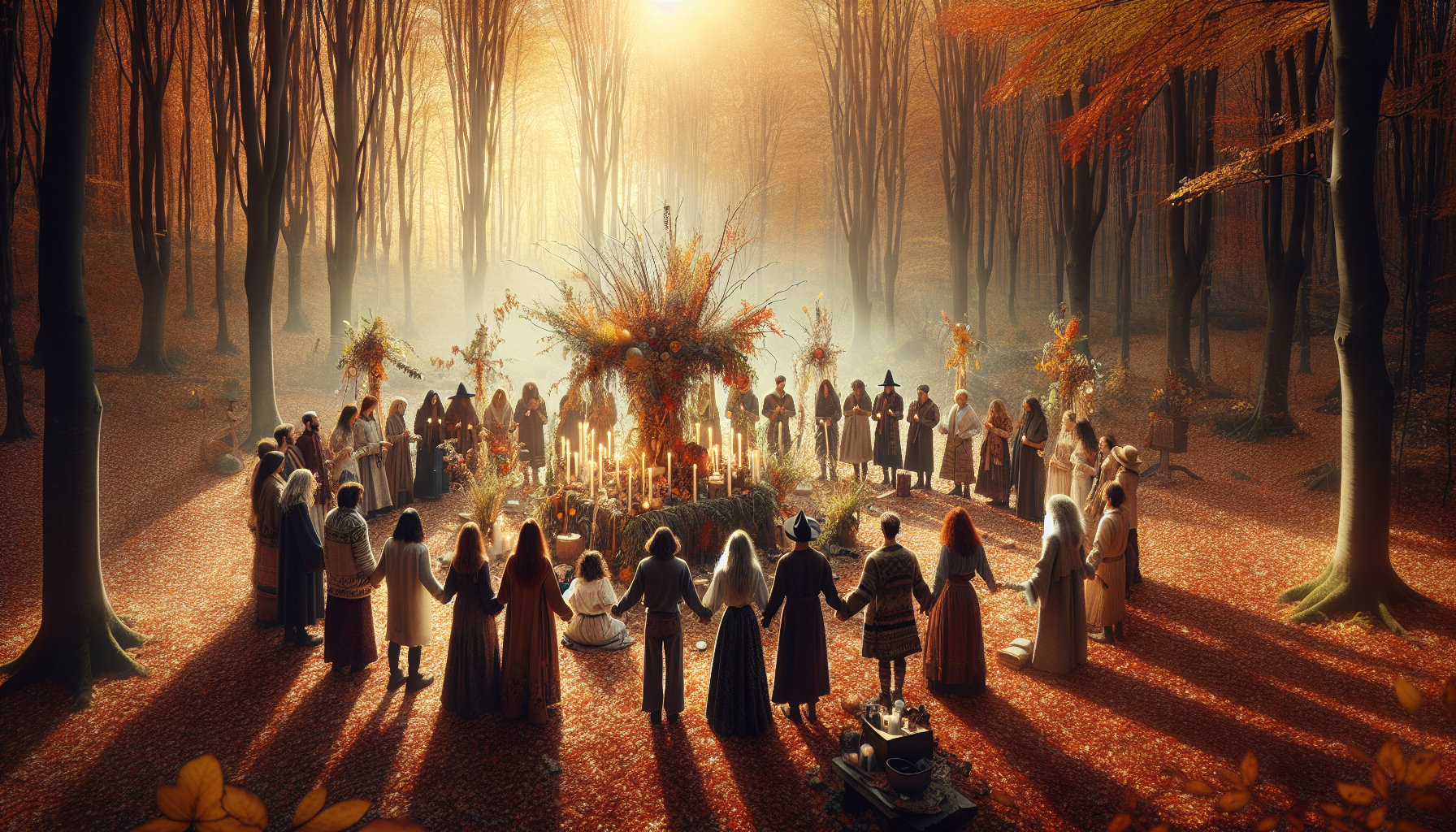In the vast tapestry of nature, there exists a multitude of extraordinary phenomena that continue to baffle and amaze even the most seasoned scientists. Among these wonders is the seemingly unassuming frog, a creature that has hopped its way into the annals of folklore and scientific inquiry alike. Frogs have long been associated with rain—ancient cultures revered them as mystical weather prophets, capable of heralding the onset of much-needed showers. But how accurate is this amphibian intuition, really? As it turns out, frogs possess a remarkable ability to predict rainfall with a precision that rivals our modern meteorological instruments. 🌧️
Imagine a world where we could foretell the weather not with radar and satellites, but through the chorus of croaks and ribbits echoing from a nearby pond. This notion is not as far-fetched as it seems. Frogs have evolved over millions of years, adapting to their environments in ways that have fine-tuned their sensitivity to atmospheric changes. Their skin, a permeable barrier, makes them acutely responsive to humidity and pressure shifts, while their breeding cycles are intricately linked to rainfall patterns. These characteristics make frogs not only fascinating creatures but also living barometers of climatic conditions.
In this exploration of amphibian meteorology, we will dive deep into the science behind frogs’ weather-predicting abilities. Our journey begins by understanding the biological and environmental factors that equip frogs with this unique skill. We will examine how their physiological traits, such as skin permeability and vocalization patterns, contribute to their weather-sensitive behaviors. Furthermore, we will explore the specific species known for their predictive prowess and how their geographical distribution influences their accuracy.
Next, we will uncover the intersection of tradition and science by looking at how different cultures have historically viewed frogs as omens of rain. From indigenous tribes to rural farming communities, these stories offer a rich tapestry of human connection to nature and highlight the timeless fascination with frogs as harbingers of precipitation. We’ll delve into how these cultural perspectives align with modern scientific findings, creating a bridge between ancient wisdom and contemporary research.
Finally, we will address the implications of this knowledge in our modern world. With climate change intensifying and weather patterns becoming increasingly erratic, understanding and leveraging natural indicators like frogs could prove invaluable. We’ll discuss potential applications in agriculture and conservation, where traditional forecasting methods might fall short. As we leap into the future, it’s worth considering how these small, unassuming creatures can teach us to listen more closely to the natural world—a world that speaks in the language of rain. 🌿
So, whether you’re a weather enthusiast, a nature lover, or someone curious about the hidden intricacies of our ecosystem, this article invites you to explore the captivating connection between frogs and rainfall. Through the lens of science, culture, and environmental awareness, we will uncover the secrets held within the rhythmic calls of these amphibian oracles. Get ready to embark on a journey where every croak tells a story and each leap brings us closer to understanding the natural world’s unspoken predictions. 🐸
Understanding the Connection Between Frogs and Rainfall
Frogs have long been associated with rain, with numerous cultures around the world recognizing their ability to predict rainfall with remarkable accuracy. This connection is not just folklore; it has scientific underpinnings that are fascinating to explore. Frogs are amphibians, creatures that thrive in wet environments, which makes their biology finely tuned to changes in humidity and atmospheric pressure. When the air is moist and the pressure drops—conditions that often precede rain—frogs become more active, often leading to increased vocalization.
Studies have shown that frogs’ vocalization patterns change in response to environmental stimuli that precede rainfall. This is due to their physiological need to reproduce in wet conditions, as eggs and tadpoles need water to survive and develop. The calls of male frogs are their way of attracting mates, and these calls become more frequent and intense as humidity rises. This natural behavior makes them an excellent biological indicator of impending rain.
The relationship between frogs and weather prediction is not only of interest to scientists but also to farmers and people in regions where weather patterns significantly impact daily life. In some cultures, the sound of frogs singing is considered a reliable sign of rain, even more so than meteorological predictions. This unique relationship between biology and meteorology is a testament to the intricate connections within our natural world.
The Science Behind Frog Behavior and Weather Patterns
Frogs are ectothermic animals, meaning their body temperature and metabolic processes are influenced by the external environment. This characteristic makes them particularly sensitive to changes in atmospheric conditions. Researchers have discovered that frogs possess specialized sensors that can detect changes in humidity and pressure, which often precede a rain event. These sensors are located in their skin and are incredibly sensitive, allowing frogs to respond to slight changes in their environment.
Additionally, the biology of frogs is such that their skin needs to remain moist to allow for proper respiration and hydration. This biological necessity drives them to be more active when rain is imminent, as they seek to capitalize on the wet conditions. During these times, frogs increase their activity levels, moving around to find mates and suitable breeding sites. This behavior can serve as a natural barometer, offering insights into upcoming weather changes.
For those interested in learning more about this fascinating phenomenon, watching videos on the subject can provide valuable visual insights. Here’s a link to a comprehensive YouTube video titled “Frogs and Weather: Nature’s Barometer” from the channel Nature Insight: Frogs and Weather: Nature’s Barometer. This video delves into the mechanisms by which frogs detect and respond to weather changes, enhancing our understanding of this unique biological phenomenon.
Comparative Analysis: Frogs vs. Technology in Weather Prediction
In today’s world, technological advancements have equipped us with sophisticated tools for weather prediction. However, the simplicity and efficiency of using frogs as natural predictors have not been entirely eclipsed by technology. Let’s examine how these natural indicators compare with modern meteorological tools.
| Criteria | Frog-Based Prediction | Technology-Based Prediction |
|---|---|---|
| Accuracy | High, especially in local and immediate forecasts | High, with the ability to predict weather over larger areas and longer periods |
| Cost | Minimal, as it relies on natural observation | High, due to the need for equipment and expertise |
| Availability | Limited to regions with suitable frog populations | Widely available globally through technology |
| Environmental Impact | None, as it leverages natural behavior | Potentially significant, depending on equipment and energy use |
While technology offers a broad and data-driven approach to weather prediction, frogs provide a localized and natural alternative that remains relevant, especially in rural or indigenous communities. This comparison highlights the value of integrating traditional knowledge with modern science to enhance our understanding of weather systems and their impacts.
The Cultural Significance of Frogs as Weather Predictors
Across various cultures, frogs hold symbolic meanings and are often associated with water and fertility. In many indigenous cultures, the call of frogs is seen as a harbinger of rain, with the amphibians playing a crucial role in agricultural and ecological practices. For instance, some Native American tribes view the frog’s croak as a signal to begin planting, as rain is considered imminent.
In Asian cultures, particularly in countries like Japan and China, frogs are seen as symbols of good fortune and prosperity. Their ability to predict rain is intertwined with cultural narratives that emphasize harmony with nature. In these societies, frogs are respected for their contribution to understanding and anticipating natural events, reflecting a deep-seated appreciation for the interconnectedness of life.
- Frogs are often featured in folklore and mythology.
- In many cultures, frogs are considered symbols of rain and fertility.
- Frogs’ behavior has been used as a natural barometer for generations.
Encouraging Conservation Efforts Through Awareness
Despite their importance in ecological systems and cultural heritage, frogs are facing significant threats from habitat loss, climate change, and pollution. Raising awareness about their role in weather prediction can help foster conservation efforts, as people recognize the broader implications of losing these remarkable creatures.
Conservation initiatives can benefit from highlighting the ecological and cultural importance of frogs. By showcasing their role as natural weather predictors, we can encourage communities to engage in practices that support amphibian habitats and promote biodiversity. Efforts such as wetland restoration, pollution control, and sustainable agriculture can create environments where frogs thrive, ensuring their continued contribution to natural weather forecasting.
Moreover, educational programs that integrate traditional knowledge with scientific research can inspire a new generation of environmental stewards. These programs can emphasize the importance of biodiversity and the need to protect ecosystems that are vital to both human and ecological well-being. By fostering a deeper understanding of the interconnectedness of life, we can inspire actions that protect frogs and, by extension, our planet.

Conclusion
As we draw this exploration to a close, it becomes abundantly clear that frogs, with their incredible ability to predict rainfall, offer us a fascinating glimpse into the natural world’s interconnectedness. Throughout the article, we delved into the biological and behavioral adaptations that enable these amphibians to sense impending rain with a surprising level of accuracy. We examined various studies that highlighted how changes in atmospheric pressure and humidity levels serve as signals for these creatures, prompting their vocalizations and migrations. Furthermore, we discussed the implications of these findings for both ecological research and practical applications in weather forecasting.
The core of our exploration centered around understanding the sensory mechanisms frogs use to detect changes in their environment. Through scientific studies and observational data, we’ve seen that frogs are attuned to the subtlest shifts in atmospheric conditions, responding in ways that ensure their survival and reproduction. The article outlined how their calls, often heard before rain, serve not only as a mating ritual but also as a herald of the coming weather changes. This dual function underscores the complex interplay between biology and ecology in shaping animal behavior.
Importantly, the insights gained from studying frogs extend beyond academic curiosity. They offer practical benefits, particularly in regions where modern meteorological tools are scarce or inaccessible. Local communities have long relied on frog behavior as a natural barometer, a testament to traditional knowledge that predates modern technology. By validating these traditional observations through scientific inquiry, we reinforce the value of indigenous knowledge systems and their potential role in contemporary environmental monitoring.
Moreover, understanding frogs’ predictive abilities can inspire innovations in bio-mimetic technologies. Researchers can draw parallels between amphibian sensory systems and technological sensors, leading to advancements in environmental monitoring tools that mimic biological processes. Such innovations hold promise for enhancing the precision of weather predictions, potentially improving agricultural planning and disaster preparedness.
The broader ecological implications of our findings cannot be overstated. Frogs are often considered indicator species, reflecting the health of their ecosystems. Their sensitivity to environmental changes makes them invaluable allies in assessing ecological integrity and identifying early signs of ecological disturbances. Protecting these creatures and their habitats is, therefore, not just a conservation priority but a strategic investment in sustaining the natural systems that support human life.
As we stand on the precipice of environmental challenges exacerbated by climate change, the lessons learned from frogs remind us of the urgency to adopt sustainable practices and to respect the intricate web of life. Their story is a compelling narrative of adaptation and survival, urging us to listen more closely to the natural world and to appreciate the wisdom it holds.
In closing, we invite you, our readers, to reflect on the wonders of nature and the knowledge it offers. Consider how the lessons from frogs might be applied in your own life, whether through supporting conservation efforts, engaging with citizen science projects, or simply observing the natural world with renewed curiosity. Share this article with others to spark conversations about the hidden intelligence in nature and its relevance to our future.
Your thoughts and insights are invaluable to us. We encourage you to comment below, sharing your perspectives or experiences related to the fascinating relationship between animals and weather patterns. Engage with us on social media, or reach out to your local environmental organizations to discover how you can contribute to preserving the natural habitats that make such studies possible.
Together, let us leap into a future where the harmony between humanity and nature is not just a vision but a vibrant reality. 🌿
Gabriel is a visual storyteller and symbolic naturalist whose creations explore the veiled ecologies and ancestral ties between humans and the living world, as echoed through myth and memory. With a sensitivity attuned to the sacred, Gabriel unveils the ancient choreography of plant, animal, and spirit — a realm where forests spoke in signs, rivers kept secrets, and every flower bore a forgotten name.
His path winds through the esoteric — tracing the rituals of forest sages, the herbal codes of ancestral healers, and the silent agreements that once guided human life in deep reciprocity with nature. From moss-covered shrines to twilight groves, Gabriel’s work reveals relationships once vital, now buried beneath layers of modern detachment.
With a foundation in visual design and the aesthetics of ancestral wisdom, Gabriel weaves storytelling into sacred ecology. His work doesn’t just depict — it channels. Drawing from myth, mysticism, and lost herbal traditions, he crafts images and narratives that pulse with the old knowing: that nature is not scenery, but kin and teacher.
Through collections of symbolic visuals, myth-rooted studies, and intuitive reflections, Gabriel invites others to rekindle forgotten senses — to listen not only with ears, but with intuition, memory, and reverence.
His work is a tribute to:
-
The mythic language of trees, stones, and roots
-
Forgotten pacts between healers and the wild
-
The sacred intelligence in nature’s unseen patterns
Whether you walk with the lore of plants, dream with the rhythms of the earth, or simply feel the call of something older in the wind through the leaves, Gabriel welcomes you into a space where symbolism, spirit, and wild nature entwine — one myth, one leaf, one vision at a time.





